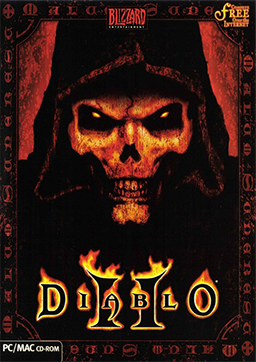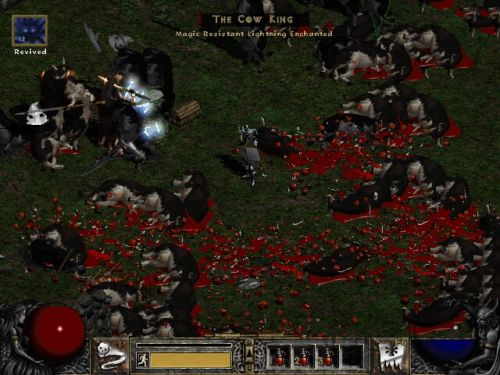
Diablo 2 (2000)
As good as the original Diablo was, the sequel was a vast improvement in every area. As the new milennium began, Diablo had been out for more than three years, and fans were clamoring for more. The sequel delivered, bringing more classes, a better story, awesome environments, interface tweaks, and, best of all, more loot. All of these things combined to make Diablo 2 one of the greatest sequels ever.
The best improvement had to be the huge variety in class and skill options. While the original three classes were somewhat homogenous, the classes in Diablo 2 were vastly different from one another. The Barbarian was a brutal melee force, and the other hand-to-hand focused class, the Paladin, used auras and played totally differently. The Sorceress was perhaps the most familiar, with many of the same spells as had been in the first game. The Necromancer used vile undead magic, and the Amazon, similar to the Rogue, was a force to be reckoned with whether using bows, javelins, or spears. All five classes were quite distinct from one another, a vast improvement over the sameness of the original.
A totally revised skill system replaced spellbooks. Instead of random chance determining your best attack methods, players could now choose from a virtual buffet of powerful abilities. With three different skill trees available, even characters of the same class could play much differently from one another. The Necromancer was a great example; a Necro skilled in Summoning could hang back and let the pet do the work, while one focused on the Curse tree could debilitate Diablo’s minions, greatly reducing their strength. With five classes and many different viable builds for each, there was something new to try every time you played.

Another major change to Diablo 2 was the scale of the game, both the environments and the story itself. No longer was the player stuck in a dungeon beneath one small town. Throughout the four acts, the story took players from a bleak desert to a lush jungle to the plane of Pandemonium. Though dungeons were scattered throughout the game, a good portion of the action took place in large open areas, adding a sense of exploration and discovery to the experience. The storyline was quite satisfying, tying in nicely to the original game but adding an epic, world-shattering significance to the quest.
While the beloved prefix and suffix item system would return, it was greatly enhanced by the addition of socketed items and crafting. Various gems of different sizes and properties dropped throughout the game. These gems could be placed into socketed items, allowing you to customize a weapon or piece of armor to your exact needs. The greatest quest item ever, the Horadric Cube, gave you additional backpack space and allowed you to transmute items. Small gems could be combined into larger ones, potions and common weapons could be altered, and even rare items could be improved, if you knew the right combination. Diablo 2 was a loot fan's dream, with something new and better to look forward to no matter what level you were.